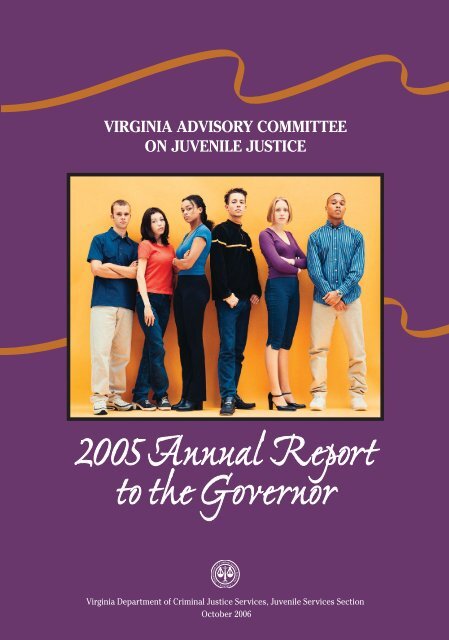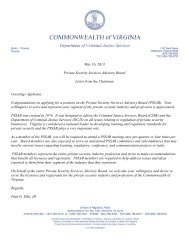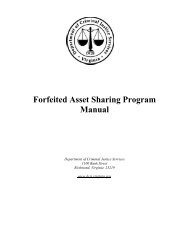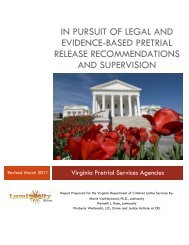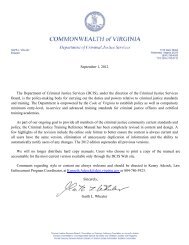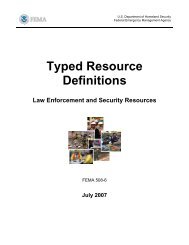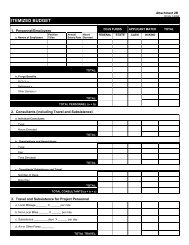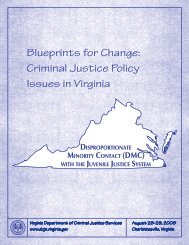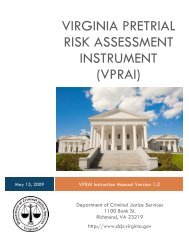2005 Annual Report - Virginia Department of Criminal Justice Services
2005 Annual Report - Virginia Department of Criminal Justice Services
2005 Annual Report - Virginia Department of Criminal Justice Services
You also want an ePaper? Increase the reach of your titles
YUMPU automatically turns print PDFs into web optimized ePapers that Google loves.
<strong>Virginia</strong> advisory committee<br />
on Juvenile <strong>Justice</strong><br />
<strong>2005</strong> <strong>Annual</strong> <strong>Report</strong><br />
to the Governor<br />
<strong>Virginia</strong> <strong>Department</strong> <strong>of</strong> <strong>Criminal</strong> <strong>Justice</strong> <strong>Services</strong>, Juvenile <strong>Services</strong> Section<br />
October 2006
<strong>Virginia</strong> Advisory Committee on Juvenile <strong>Justice</strong><br />
Table <strong>of</strong> Contents<br />
Introduction...................................................................................................... 1<br />
Advisory Committee on Juvenile <strong>Justice</strong>.......................................................... 2<br />
Priorities and Accomplishments....................................................................... 3<br />
Juvenile <strong>Justice</strong> and Delinquency Prevention (JJDP) Grant Programs........... 14<br />
Title II Formula Grants............................................................................. 14<br />
Title V Prevention Grants......................................................................... 18<br />
Juvenile Accountability Block Grants (JABG).......................................... 20<br />
Challenge Awards..................................................................................... 22<br />
Juvenile <strong>Justice</strong> and Delinquency Prevention Act Requirements................... 23<br />
Deinstitutionalization <strong>of</strong> Status Offenders............................................... 24<br />
Sight and Sound Separation..................................................................... 25<br />
Removal <strong>of</strong> Juveniles from Adult Jails and Lockups................................ 26<br />
Addressing Minority Overrepresentation................................................. 26
Introduction<br />
This <strong>Annual</strong> <strong>Report</strong> <strong>of</strong> the Advisory Committee on Juvenile <strong>Justice</strong> describes its activities<br />
for fiscal year <strong>2005</strong>. It includes funding priorities, issues and accomplishments in juvenile<br />
justice, details about awarded grants and Challenge funds, and data concerning <strong>Virginia</strong>’s<br />
monitoring <strong>of</strong> the four core requirements <strong>of</strong> the federal Juvenile <strong>Justice</strong> and Delinquency<br />
Prevention Act.<br />
Members <strong>of</strong> the Advisory Committee on Juvenile <strong>Justice</strong> are appointed by the Governor .<br />
The Committee is composed <strong>of</strong> individuals who are knowledgeable about the prevention<br />
and treatment <strong>of</strong> juvenile delinquency and the juvenile justice system. It includes representatives<br />
<strong>of</strong> local law enforcement, juvenile justice agencies, state and local government,<br />
judges, counsel for children, and other citizens, including youth. Membership requirements<br />
are specified in the federal Juvenile <strong>Justice</strong> and Delinquency Prevention Act .<br />
The Committee is responsible for reviewing the operation <strong>of</strong> the juvenile justice system in<br />
<strong>Virginia</strong>, for recommending needs and priorities for the development and improvement <strong>of</strong><br />
the juvenile justice system, for recommending grant awards, and for advising the Governor<br />
on matters related to the Juvenile <strong>Justice</strong> and Delinquency Prevention Act.<br />
The Advisory Committee reports to the <strong>Criminal</strong> <strong>Justice</strong> <strong>Services</strong> Board, the governing board<br />
<strong>of</strong> the <strong>Virginia</strong> <strong>Department</strong> <strong>of</strong> <strong>Criminal</strong> <strong>Justice</strong> <strong>Services</strong> (DCJS). The Advisory Committee<br />
makes recommendations to the <strong>Criminal</strong> <strong>Justice</strong> <strong>Services</strong> Board on awards under three<br />
federal JJDP Act grants: Title II Formula Grants, Title V Delinquency Prevention Grants,<br />
and Juvenile Accountability Block Grants. It also approves funding priorities for Part E<br />
Challenge funds .<br />
For information about other grant programs and activities <strong>of</strong> DCJS related to children, refer<br />
to <strong>Virginia</strong>’s Three Year Plan, 2006-2008, which is available on the agency web site at www.<br />
dcjs.virginia.gov/juvenile/publications.<br />
<br />
Code <strong>of</strong> <strong>Virginia</strong>, § 9.1-111<br />
<br />
Juvenile <strong>Justice</strong> and Delinquency Prevention Act <strong>of</strong> 2002, 42 U.S.C. § 5633, Sec. 223 (a) available online at<br />
http://ojjdp.ncjrs.org/about/apprendixa1.html.<br />
<br />
The federal Challenge grant program has ended. Final awards to states were given in fiscal year 2003. States<br />
continue to award those funds.
<strong>Virginia</strong> Advisory Committee on Juvenile <strong>Justice</strong><br />
<strong>Virginia</strong> Advisory Committee<br />
on Juvenile <strong>Justice</strong> <br />
Citizen Appointees<br />
Mr. Benjamin J. Andrews<br />
Vienna<br />
Mr. Kevin Appel N<br />
Arlington<br />
Mr. Henry N. Azais F<br />
Manassas<br />
The Hon. Warner D.<br />
“Dave” Chapman N<br />
Charlottesville<br />
Ms. Monica Estrada N<br />
Chesterfield<br />
Mr. Peter Feddo Y, N<br />
Chester<br />
Mr. Russell Foot F<br />
Chesapeake<br />
Mr. Matthew Gowin Y<br />
Burkeville<br />
Ms. Eileen Grey N<br />
Alexandria<br />
Mr. Scott Grimes F<br />
Doswell<br />
Supervisor Mary K. Hill F<br />
Woodbridge<br />
Mr. Andrew Jennings Y, N<br />
Hillsville<br />
Judge Jerrauld Jones N<br />
Norfolk<br />
Ms. Susan C. Laughrun F<br />
Hampton<br />
Dr. Jay W. Malcan<br />
Richmond<br />
Mr. Charles Martin<br />
Charlottesville<br />
Mr. Kevin Massengill F<br />
Sutherland<br />
Ms. Sophia McEachin Y,N<br />
Richmond<br />
Chief Rodney D. Monroe N<br />
Richmond<br />
Sheriff Charles W. Phelps N<br />
Isle <strong>of</strong> Wight<br />
Mr. Daniel L. Plaugher Y<br />
Richmond<br />
Pr<strong>of</strong>essor Robert E. Shepherd<br />
Jr.<br />
Richmond<br />
Mr. Michael Stewart N<br />
<strong>Virginia</strong> Beach<br />
Mr. Wayne Thomas (Chair)<br />
Richmond<br />
Mrs. Ruby G. Turner<br />
Richmond<br />
Judge Sharon Breeden Will F<br />
Richmond<br />
Mr. Justin Wilson Y, F<br />
Alexandria<br />
Captain Barry J. Wittig F<br />
Harrisonburg<br />
Ms. Gina E. Wood<br />
Alexandria<br />
Legislative Appointees<br />
The Honorable Linda T. Puller<br />
Mt. Vernon, <strong>Virginia</strong><br />
The <strong>Virginia</strong> Senate<br />
State Government Representatives<br />
Dr. Jo Lynne DeMary F<br />
Dr. Billy K. Cannaday Jr. N<br />
Superintendent<br />
<strong>Virginia</strong> <strong>Department</strong> <strong>of</strong> Education<br />
(Proxy: Dr. Cynthia A. Cave)<br />
Mr. Anthony Conyers, Commissioner<br />
<strong>Virginia</strong> <strong>Department</strong> <strong>of</strong> Social <strong>Services</strong><br />
(Proxy: Ms. Jane B. Brown)<br />
The Honorable Robert F. McDonnell F<br />
The Honorable Robert B. Bell N<br />
Charlottesville<br />
The <strong>Virginia</strong> House <strong>of</strong> Delegates<br />
Mr. Barry Green, Director<br />
<strong>Virginia</strong> <strong>Department</strong> <strong>of</strong> Juvenile <strong>Justice</strong><br />
(Proxy: Ms. Lynette Greenfield)<br />
Dr. James S. Reinhard, Commissioner<br />
<strong>Virginia</strong> <strong>Department</strong> <strong>of</strong> Mental Health, Mental<br />
Retardation, & Substance Abuse <strong>Services</strong>.<br />
(Proxy: Ms. Janet Lung)<br />
<br />
<br />
This listing includes members as <strong>of</strong> the end <strong>of</strong> the <strong>2005</strong> fiscal year, June 30, <strong>2005</strong>, and new members appointed<br />
between July 1, <strong>2005</strong> and October 31, 2006.<br />
Notes. N designates new members; F designates former members; Y designates youth members. Youth members .<br />
must be younger than age 24 at the time <strong>of</strong> their appointment.
Priorities and Accomplishments in<br />
<strong>Virginia</strong>’s Juvenile <strong>Justice</strong> System,<br />
F y <strong>2005</strong><br />
This section contains descriptions <strong>of</strong> funding priorities in <strong>Virginia</strong>’s juvenile justice system<br />
in FY <strong>2005</strong> and the accomplishments that relate to those priorities.<br />
Funding priorities are determined through a planning process that includes data analysis and<br />
input from constituent groups. They are developed across all grant programs administered<br />
by the Advisory Committee on Juvenile <strong>Justice</strong> – Title II Formula Grants, Title V Prevention<br />
Grants, Juvenile Accountability Block Grants, and Challenge funds. The Advisory Committee<br />
on Juvenile <strong>Justice</strong> makes the final determination <strong>of</strong> priorities.<br />
Priorities<br />
Priorities for the <strong>2005</strong> fiscal year are shown in the box. They include two additions to the<br />
2004 priorities – gangs and aftercare/reentry – and reordering <strong>of</strong> the 2004 priorities.<br />
They were funded under various funding streams. Alternatives to detention, young juvenile<br />
<strong>of</strong>fenders, truancy, and minority<br />
overrepresentation were priorities<br />
for Title II funding. The legal representation<br />
<strong>of</strong> juveniles, truancy, and<br />
mental health problems <strong>of</strong> juveniles<br />
were priorities for Challenge<br />
funding. Alternatives to detention,<br />
aftercare services, and juvenile sex<br />
♦<br />
♦<br />
♦<br />
♦<br />
♦<br />
Priorities: <strong>2005</strong> Fiscal Year<br />
Detention Alternatives<br />
Aftercare/Reentry<br />
Disproportionate Minority Contact<br />
Mental Health Needs<br />
Sex Offenders<br />
<strong>of</strong>fender treatment were Juvenile<br />
♦<br />
Legal Representation<br />
Accountability Block Grant (JABG)<br />
♦<br />
Young Juvenile Offenders<br />
priorities.<br />
No new Title V funds were available.<br />
However, continuation grants were<br />
funded that replicated model prevention<br />
programs.<br />
♦<br />
♦<br />
♦<br />
Rural <strong>Services</strong><br />
Truancy<br />
Gangs<br />
The following pages provide descriptions <strong>of</strong> the priorities and <strong>of</strong> <strong>Virginia</strong>’s accomplishments<br />
in addressing those priorities.
<strong>Virginia</strong> Advisory Committee on Juvenile <strong>Justice</strong><br />
Issue<br />
It is known that detention<br />
is harmful for low-risk<br />
<strong>of</strong>fenders ; it exposes them<br />
to delinquent peers and that<br />
exposure is a predictor <strong>of</strong><br />
delinquency .<br />
<strong>Virginia</strong> detains juveniles at<br />
a rate that far exceeds the<br />
national average and the<br />
rates <strong>of</strong> adjoining states, as<br />
the chart shows.<br />
In FY <strong>2005</strong>, there were over<br />
17,000 admissions <strong>of</strong> children<br />
to secure detention<br />
facilities in <strong>Virginia</strong>. In comparison,<br />
there were less than<br />
Providing Alternatives to Detention<br />
1,000 commitments to juvenile correctional centers. The average stay <strong>of</strong> children in secure<br />
detention facilities is 3-4 weeks whereas it is 1-2 years in juvenile correctional centers. The<br />
disparity in numbers suggests that more children may be detained than is necessary.<br />
Over one-third <strong>of</strong> admissions are for technical violations such as probation or parole violations,<br />
contempt <strong>of</strong> court, or failure to appear. Indeed, they are the most frequent most<br />
serious committing <strong>of</strong>fense.<br />
Accomplishments<br />
♦<br />
Comparative Detention Rates per 100,000<br />
Juvenile Population, 2003<br />
140<br />
120<br />
100<br />
80<br />
60<br />
40<br />
20<br />
In this count, detained juveniles await court hearings, adjudication, disposition, or<br />
placement elsewhere. Represents 906 detained juveniles.<br />
Data Source: Sickmund, M., Sladky, T., & Kang, W (<strong>2005</strong>) Census <strong>of</strong> Juveniles in Residential Placement Databook.<br />
Online at www.ojjdp.ncjrs.org/ojstatbb/cjrp<br />
0<br />
<strong>Virginia</strong> U.S. Total Kentucky<br />
North<br />
Carolina<br />
Maryland Tennessee<br />
West<br />
<strong>Virginia</strong><br />
Rate - One Day Census 110 83 50 57 75 38 83<br />
Prepared by: Juvenile <strong>Services</strong> Section, DCJS.<br />
In the 2004 and <strong>2005</strong> legislative sessions, legislation was passed which ensures that<br />
youth charged with felony <strong>of</strong>fenses cannot waive representation by an attorney without<br />
consulting with an attorney (<strong>Virginia</strong> Code 16.1-266). The change in legislation was<br />
effective July 1, <strong>2005</strong>. With counsel earlier in the process, it is expected that fewer<br />
children will be detained predispositionally.<br />
♦<br />
The <strong>Virginia</strong> <strong>Department</strong> <strong>of</strong> Juvenile <strong>Justice</strong> continues to participate in the Annie E.<br />
Casey Foundation’s Juvenile Detention Alternatives Initiative. This initiative aims to<br />
ensure that only those children who require detention are held. One expected impact <strong>of</strong><br />
this initiative is to reduce the number <strong>of</strong> children detained for technical violations.<br />
<br />
<br />
Bell, James. Presentation at the <strong>Virginia</strong> <strong>Department</strong> <strong>of</strong> Juvenile <strong>Justice</strong> Disproportionate Minority Contact<br />
conference, Crystal City, <strong>Virginia</strong>. June 28, 2004.<br />
<br />
Hawkins, J., Herrenkohl, T., Farrington, D., Brewer, D. Catalano, R., Harachi, T., & Cothern, L. (2000).<br />
Predictors <strong>of</strong> youth violence. Juvenile <strong>Justice</strong> Bulletin. Washington, D.C.: U.S. <strong>Department</strong> <strong>of</strong> <strong>Justice</strong>, Office <strong>of</strong><br />
<strong>Justice</strong> Programs, Office <strong>of</strong> Juvenile <strong>Justice</strong> and Delinquency Prevention.<br />
<br />
This represents 10,532 children <strong>of</strong> whom about 65% were admitted once and the rest multiple times during<br />
the fiscal year.
♦<br />
♦<br />
♦<br />
DCJS has continued the Juvenile Accountability Block Grant (JABG) to the <strong>Department</strong> <strong>of</strong><br />
Juvenile <strong>Justice</strong> to allow those pilot localities participating in the detention alternatives<br />
initiative to provide alternatives to detention. This grant is designed to provide successful<br />
community models that can be implemented locally after the grant has terminated.<br />
In FY<strong>2005</strong>, 4 new Title II grants were funded that provide local detention expeditors to<br />
search out alternatives to detention (Hampton, Loudoun, Norfolk, Newport News).<br />
Challenge funds were provided to the Indigent Defense Commission for a series <strong>of</strong><br />
workshops for juvenile defenders, “Advocating Release: Alternatives to Detention”. The<br />
workshops began in the 2006 fiscal year.<br />
Issue<br />
Juveniles released from <strong>Virginia</strong> juvenile correctional centers are re<strong>of</strong>fending at high rates.<br />
As the chart shows, within<br />
three years, more than<br />
three-fourths <strong>of</strong> them have<br />
been rearrested.<br />
Two-thirds have been<br />
reconvicted.<br />
More than half have been<br />
reincarcerated.<br />
Most juveniles are held in<br />
correctional centers for 1-2<br />
years. Given the recidivism<br />
data, attention is needed<br />
to the types <strong>of</strong> programs<br />
<strong>of</strong>fered and their implementation<br />
in the correctional centers, to the reintegration <strong>of</strong> children into their communities<br />
and to aftercare services for them.<br />
Incarceration in a juvenile correctional facility is expensive. In <strong>2005</strong>, the annual per capita cost<br />
was $88,271 , which includes $17,808 <strong>Department</strong> <strong>of</strong> Correctional Education per capita cost.<br />
Accomplishments<br />
♦<br />
Recidivism Rates for Juveniles Released from<br />
<strong>Virginia</strong> Juvenile Correctional Centers in 2002<br />
100<br />
80<br />
60<br />
40<br />
20<br />
Reincarceration rate is to a juvenile correctional center, <strong>Department</strong> <strong>of</strong> Corrections,<br />
or a local jail.<br />
Data Source: <strong>Department</strong> <strong>of</strong> Juvenile <strong>Justice</strong> Data Resource Guide, FY <strong>2005</strong>.<br />
Prepared by: Juvenile <strong>Services</strong> Section, DCJS.<br />
The <strong>Department</strong> <strong>of</strong> Juvenile <strong>Justice</strong> received continuation funding for its Juvenile<br />
Accountability Block Grant for a transitional living program to provide independent<br />
living beds for juveniles as a step-down from commitment in a juvenile correctional<br />
center or transition from a halfway house.<br />
0<br />
Rearrest Reconviction Reincarceration<br />
Percentage One Year 52.3 43 22.8<br />
Percentage Two Years 70.5 60.7 42.4<br />
Percentage Three Years 78.1 68.2 53.7<br />
<br />
<strong>Virginia</strong> <strong>Department</strong> <strong>of</strong> Juvenile <strong>Justice</strong> (<strong>2005</strong>), Data Resource Guide: Fiscal Year <strong>2005</strong> (p.194). Richmond,<br />
<strong>Virginia</strong>.
<strong>Virginia</strong> Advisory Committee on Juvenile <strong>Justice</strong><br />
Disproportionate Minority Contact<br />
with the Juvenile <strong>Justice</strong> System<br />
<br />
Issue<br />
Racial disparity in the juvenile<br />
justice system may not<br />
be based on racial discrimination<br />
exclusively. It may<br />
result from school policies,<br />
targeting <strong>of</strong> crime-ridden<br />
neighborhoods, inability<br />
<strong>of</strong> the indigent to retain<br />
paid counsel, and lack <strong>of</strong><br />
available prevention opportunities<br />
and alternatives to<br />
detention in economically<br />
deprived communities.<br />
5.0<br />
4.0<br />
3.0<br />
2.0<br />
1.0<br />
0.0<br />
Relative Rate Indices, FY <strong>2005</strong><br />
State <strong>of</strong> <strong>Virginia</strong><br />
Court Intake Diverted Detained Petitioned<br />
Data Source: <strong>Department</strong> <strong>of</strong> Juvenile <strong>Justice</strong><br />
Indices computed by Juvenile <strong>Services</strong> Section, DCJS<br />
Confined -<br />
JCCs<br />
African Amer. 2.60 0.91 1.31 1.03 2.49<br />
Hispanic 1.20 0.79 1.49 1.09 1.27<br />
Asian 0.30 1.28 0.98 0.91 **<br />
** insufficient cases for analysis Prepared by: Juvenile <strong>Services</strong> Section, DCJS.<br />
It is evident in <strong>Virginia</strong>.<br />
African American youth are over-represented throughout the juvenile justice system in<br />
<strong>Virginia</strong>, relative to their percentage in the juvenile population. For the State, the juvenile<br />
at-risk population aged 10-17 is about 825,000 children. The racial distribution is about 65%<br />
white, 25% African American, 6% Hispanic and 4% Asian.<br />
The relative rate index is a measure <strong>of</strong> disproportionate minority contact with the juvenile<br />
justice system. It provides a means <strong>of</strong> comparison <strong>of</strong> white to minority juveniles. As the<br />
graph indicates, African American children at the state level are more than twice as likely to<br />
be referred to court as white children. Hispanic children are about as likely as white children<br />
to be brought to court whereas Asian children are less likely. Numerically, about 64,000<br />
children were referred to court in FY <strong>2005</strong>. About 30,000 were white and about 29,000 were<br />
African American.<br />
As the chart shows, the relative rate index for diverted and petitioned juveniles is close to<br />
1.0, indicating that no racial disproportionality is evident at the diverted and petitioned<br />
stages.<br />
At the detention stage, both African American and Hispanic children are somewhat more<br />
likely than white children to be detained. There were about 11,000 children admitted in<br />
<strong>2005</strong> for a total <strong>of</strong> about 17,000 admissions as many were admitted more than once. The<br />
racial distribution <strong>of</strong> admissions was about 9,000 African American, 7,000 white and 1,000<br />
Hispanic. The average stay is about 3 weeks.<br />
African Americans are more than twice as likely to be committed to juvenile correctional<br />
centers. As only 9 Asian children were committed to juvenile correctional centers, the index<br />
for Asian children is not shown. About 1,000 children were committed – about 300 white,<br />
700 African American and less than 100 Hispanic. The average stay is 1 – 2 years.
Accomplishments<br />
♦<br />
The Juvenile <strong>Services</strong> Section, DCJS, continued activities designed to address this<br />
issue.<br />
• The DCJS fact sheet, Reducing Minority Overrepresentation in <strong>Virginia</strong>’s Juvenile <strong>Justice</strong><br />
System, was published in the 2003 fiscal year and reprinted in the <strong>2005</strong> fiscal<br />
year. It has been distributed widely and is available online at www.dcjs.virginia.<br />
gov/juvenile/publications.<br />
• The Disproportionate Minority Contact Coordinator continues to provide training<br />
and assistance to local <strong>of</strong>ficials and detention staff.<br />
• DCJS Juvenile <strong>Services</strong> Section maintains a Juvenile <strong>Justice</strong> System Demographics web<br />
page, at www.dcjs.virginia.gov/juvenile. The web page is accessed frequently.<br />
♦<br />
Disproportionate contact <strong>of</strong> African American children with the system may be best<br />
addressed indirectly through seeking alternatives to detention and improving the legal<br />
representation <strong>of</strong> children. Those priorities and accomplishments related to them are<br />
described elsewhere in this Section.<br />
Issue<br />
Mental Health Needs <strong>of</strong> Juvenile Offenders<br />
Many children in <strong>Virginia</strong>’s juvenile justice system have demonstrated mental health needs.<br />
In 2003, 23% <strong>of</strong> males and 42% <strong>of</strong> females committed to <strong>Virginia</strong> juvenile correctional<br />
centers had a history <strong>of</strong> prior psychiatric hospitalization.<br />
The juvenile justice system is used also as an alternative treatment resource for children with<br />
mental health needs who do not otherwise need to be in the system. Thus, mental illness is<br />
becoming criminalized. A 2002 report <strong>of</strong> the American Bar Association recommends,<br />
The Commonwealth should address the increase in mental health and schoolrelated<br />
referrals to juvenile court and evaluate their appropriateness, especially<br />
as this impacts minority youth. 10<br />
Accomplishments<br />
♦<br />
DCJS Challenge grant funds were provided to the University <strong>of</strong> <strong>Virginia</strong> to develop a<br />
cd-rom, The Kid in Trouble, which provides a tutorial for juvenile justice pr<strong>of</strong>essionals<br />
on the identification, diagnosis, and treatment for children in contact with the juvenile<br />
justice system or children at risk. Distribution continued in the <strong>2005</strong> fiscal year. Because<br />
<strong>of</strong> its popularity, another 300 copies <strong>of</strong> the cd-rom were ordered.<br />
<br />
Waite, D., & Neff, J. (2004). Pr<strong>of</strong>iles <strong>of</strong> Incarcerated Adolescents in <strong>Virginia</strong>’s Correctional Facilities, Fiscal years<br />
1999-2003. Richmond, VA, <strong>Virginia</strong> <strong>Department</strong> <strong>of</strong> Juvenile <strong>Justice</strong>.<br />
10<br />
American Bar Association Juvenile <strong>Justice</strong> Center & Mid-Atlantic Juvenile Defender Center (2002). <strong>Virginia</strong>:<br />
An Assessment <strong>of</strong> access to counsel and quality <strong>of</strong> representation in delinquency proceedings. Washington, D.C.:<br />
American Bar Association.
<strong>Virginia</strong> Advisory Committee on Juvenile <strong>Justice</strong><br />
♦<br />
♦<br />
JABG funds were used to provide funding to DMHMRSAS to provide mental health services<br />
to children in five detention facilities. This grant includes funding for transition<br />
services for these children to receive mental health treatment in their communities.<br />
The grant was continued for the <strong>2005</strong> fiscal year.<br />
One <strong>of</strong> the sessions at the <strong>2005</strong> annual Juvenile <strong>Justice</strong> and Delinquency Prevention<br />
conference addressed mental health needs <strong>of</strong> children in the juvenile justice system.<br />
Issue<br />
Juvenile Sex Offenders<br />
Juvenile sex <strong>of</strong>fenders are a population <strong>of</strong> concern. They have multiple treatment needs and<br />
require specialized aftercare and supervision in the community. They pose a risk to public<br />
safety. Some are committed to the <strong>Department</strong> <strong>of</strong> Juvenile <strong>Justice</strong> and treated in <strong>Virginia</strong><br />
juvenile correctional centers. Some are treated in the community.<br />
They are <strong>of</strong>ten quite young. Of the 635 children referred to court services unit intake for<br />
sex <strong>of</strong>fenses in <strong>2005</strong>, 29% were aged 13 and younger and over 40% (44%) were aged 14<br />
and younger.<br />
Treatment works. <strong>Virginia</strong> research supports the efficacy <strong>of</strong> treatment for juvenile sex<br />
<strong>of</strong>fenders. Research funded by a Juvenile Accountability Block Grant 11 indicates that the rate<br />
<strong>of</strong> sex <strong>of</strong>fense re-arrest for juvenile sex <strong>of</strong>fenders who have completed sex <strong>of</strong>fender treatment<br />
in <strong>Virginia</strong> juvenile correctional centers, is about 7% within ten years 12 . Their 10-year<br />
re-arrest rates for other <strong>of</strong>fenses, although higher, are all well below the 3-year 78% re-arrest<br />
rate for the juvenile correctional center population released in 2002 13 .<br />
National research indicates that most juvenile sex <strong>of</strong>fenders are not destined to become<br />
adult sex <strong>of</strong>fenders 14 .<br />
Accomplishments<br />
♦<br />
The <strong>Department</strong> <strong>of</strong> Juvenile <strong>Justice</strong> received continuation JABG grant funding for community<br />
sex <strong>of</strong>fender treatment, which it dispersed to the 13 th , 16 th , 19 th , 20 th and 31 st<br />
district court services units.<br />
♦<br />
The Portmouth/Tidewater Regional Group Home Commission received a Title II grant<br />
for sex <strong>of</strong>fender treatment programs.<br />
<br />
11<br />
At the time <strong>of</strong> funding, the program was called the Juvenile Accountability Incentive Block Grant.<br />
12<br />
Pinkerton, R. (June, 2003). Juvenile sex <strong>of</strong>fenders: Current treatment techniques and recidivism data. Presentation at<br />
the Juvenile <strong>Justice</strong> and Delinquency Prevention Conference, Williamsburg, <strong>Virginia</strong>.<br />
13<br />
<strong>Virginia</strong> <strong>Department</strong> <strong>of</strong> Juvenile <strong>Justice</strong>, Data resource guide, FY <strong>2005</strong>.<br />
14<br />
Center for Sex Offender Management. (2002) An overview <strong>of</strong> sex <strong>of</strong>fender management. Silver Spring, MD: Center<br />
for Sex Offender Management. (Available online at www.csom.org.)
Issue<br />
Legal Representation <strong>of</strong> Juveniles<br />
In 2002, the American Bar Association and the Mid-Atlantic Defender Center published a<br />
report about the legal representation <strong>of</strong> juveniles in <strong>Virginia</strong> 15 that indicated that access to<br />
legal counsel and quality representation in delinquency proceedings is lacking in <strong>Virginia</strong>.<br />
This assessment reveals significant gaps in indigent defense practices, including<br />
flaws in the appointment process, lack <strong>of</strong> time and resources to adequately prepare<br />
a case, a tendency to accept plea <strong>of</strong>fers rather than aggressively protect the rights<br />
and needs <strong>of</strong> children and the near absence <strong>of</strong> any post-dispositional legal representation.<br />
The system, as it is presently structured, is, at best, uneven, and clearly<br />
has had a disproportionate impact on poor and minority children (page 1).<br />
At the time <strong>of</strong> the report, in <strong>Virginia</strong>, counsel was not appointed until the detention hearing.<br />
The practice was that only retained private counsel participated at arrest, intake, and initial<br />
detention hearings. That has changed. In the <strong>Virginia</strong> 2004 and <strong>2005</strong> General Assembly<br />
sessions, legislation passed providing that counsel would be appointed prior to the detention<br />
hearing 16 .<br />
There is a lack <strong>of</strong> available juvenile counsel. The report indicated that indigent children in<br />
jurisdictions served by public defenders fare better than those in jurisdictions where courtappointed<br />
attorneys represent juveniles. However, most jurisdictions in <strong>Virginia</strong> use the<br />
court-appointed system for juvenile representation. New legislation was enacted in 2004<br />
that addresses this issue. It expanded the responsibility <strong>of</strong> the Public Defender Commission<br />
to include court-appointed counsel for indigent clients and renamed it the Indigent Defense<br />
Commission 17 .<br />
The report also suggested that some juvenile counsel are untrained, inexperienced, unpr<strong>of</strong>essional,<br />
and incompetent. The expanded mandate <strong>of</strong> the Indigent Defense Commission<br />
includes enforcing qualification standards for attorneys seeking to become court-appointed<br />
counsel, developing training courses, and developing standards <strong>of</strong> conduct. Training responsibilities<br />
include providing additional training on representing juveniles to attorneys seeking<br />
to qualify as counsel in juvenile and domestic relations district court 18 .<br />
Accomplishments<br />
♦<br />
Legislation passed in the <strong>2005</strong> and 2006 legislative sessions that ensures that those<br />
youth charged with felony <strong>of</strong>fenses cannot waive representation by an attorney without<br />
consulting with an attorney (<strong>Virginia</strong> Code 16.1-266). The change in legislation was<br />
effective July 1, <strong>2005</strong>.<br />
15<br />
American Bar Association Juvenile <strong>Justice</strong> Center & Mid-Atlantic Juvenile Defender Center (2002). <strong>Virginia</strong>:<br />
An Assessment <strong>of</strong> access to counsel and quality <strong>of</strong> representation in delinquency proceedings. Washington, D.C.:<br />
American Bar Association.<br />
16<br />
This amends the Code <strong>of</strong> <strong>Virginia</strong>, §16.1-250.<br />
17<br />
<strong>Virginia</strong> Code, Ann. §19.2-163.01<br />
18<br />
<strong>Virginia</strong> Code, Ann. §19.2-163.01.
<strong>Virginia</strong> Advisory Committee on Juvenile <strong>Justice</strong><br />
♦<br />
♦<br />
♦<br />
Challenge funds were provided to the Indigent Defense Commission for a juvenile<br />
defender summit to train public defenders and private attorneys in October 2004.<br />
Challenge funds were provided to the Indigent Defense Commission for a series <strong>of</strong><br />
workshops for juvenile defenders, “Advocating Release: Alternatives to Detention”. The<br />
workshops began in the 2006 fiscal year.<br />
A session at the <strong>2005</strong> Juvenile <strong>Justice</strong> and Delinquency Prevention conference, Juvenile<br />
<strong>Justice</strong> Issues in the <strong>2005</strong> Legislative Session, was designed to educate and inform participants<br />
about new legislation and outstanding legislative issues.<br />
Young Juvenile Offenders<br />
Issue<br />
The number <strong>of</strong> young children having contact with the juvenile justice system has been a<br />
concern to DCJS for several years. <strong>Virginia</strong> has had the Young Juvenile Offender Initiative<br />
since 2002 with priority for Title II grants.<br />
Research has shown that a juvenile <strong>of</strong>fense at ages 6-11 is the strongest predictor <strong>of</strong> subsequent<br />
violent or serious delinquency even if the <strong>of</strong>fense did not involve violence 19 . It is the<br />
second strongest predictor for children aged 12-14.<br />
Recent <strong>Virginia</strong> data confirm the pattern <strong>of</strong> <strong>of</strong>fenses at a young age leading to later more<br />
serious delinquency. Of children committed to the <strong>Department</strong> <strong>of</strong> Juvenile <strong>Justice</strong> in 2003,<br />
almost three-fourths (73.5%) were first adjudicated at age 14 or younger 20 .<br />
Thousands <strong>of</strong> the children referred to court in <strong>Virginia</strong> each year are aged 13 or younger.<br />
Of the 63,000 children referred to court in <strong>2005</strong>, almost 10,000 (9,813) were aged 13 and<br />
younger. Some <strong>of</strong> these children are penetrating further into the system. About 1,400 <strong>of</strong><br />
the 17,000 admissions to secure detention facilities in <strong>2005</strong> were <strong>of</strong> children aged 13 or<br />
younger. Of the 992 children committed to juvenile correctional facilities in <strong>2005</strong>, 28 were<br />
aged 13 or younger. Another 78 were aged 14. The usual stay in a secure detention facility<br />
is 3-4 weeks; in a juvenile correctional facility, it is 1-2 years.<br />
Accomplishments<br />
♦<br />
The Young Juvenile Offender Initiative targets children aged 13 and younger who have<br />
had contact with the juvenile justice system. It has been a funding priority for Title II<br />
grants since 2002. Six grants were funded beginning in 2002 and continue; four additional<br />
grants were approved for funding in 2003 and began in the 2004 fiscal year. All <strong>of</strong><br />
these grants were continued in the <strong>2005</strong> fiscal year. The Young Juvenile Offender grants<br />
are designed to replicate model programs that have been demonstrated effective.<br />
10<br />
19<br />
Hawkins, J., Herrenkohl, T., Farrington, D., Brewer, D., Catalano, R., Harachi, T., & Cothern, L. (2000).<br />
Predictors <strong>of</strong> youth violence. Juvenile <strong>Justice</strong> Bulletin. Washington, D.C.: U.S. <strong>Department</strong> <strong>of</strong> <strong>Justice</strong>, Office <strong>of</strong><br />
<strong>Justice</strong> Programs, Office <strong>of</strong> Juvenile <strong>Justice</strong> and Delinquency Prevention.<br />
20<br />
Waite, D., & Neff, J. (2004). Pr<strong>of</strong>iles <strong>of</strong> incarcerated adolescents in <strong>Virginia</strong>’s correctional facilities, Fiscal years 1999-<br />
2003. Richmond, VA, <strong>Virginia</strong> <strong>Department</strong> <strong>of</strong> Juvenile <strong>Justice</strong>.
♦<br />
♦<br />
♦<br />
♦<br />
A cross-site evaluation <strong>of</strong> the Young Juvenile Offender project sites has been funded<br />
since 2002 to measure for re-<strong>of</strong>fense rates including new intakes, petitions, and adjudications;<br />
detention and commitment rates; school enrollment, attendance, behavior,<br />
and academic performance.<br />
A plenary session and workshop at the <strong>2005</strong> annual Juvenile <strong>Justice</strong> and Delinquency<br />
Prevention conference highlighted the principles <strong>of</strong> effective intervention with youthful<br />
<strong>of</strong>fenders.<br />
A Title V continuation grant to James City County targets middle school students.<br />
Title V continuation grants to Newport News and Richmond provide cognitive/behavioral<br />
training for families with children aged 6-12 using the Strengthening Families model<br />
program.<br />
Issue<br />
Access to <strong>Services</strong> for Juveniles in Rural Localities<br />
Access to services for juveniles who have had contact with the juvenile justice system is<br />
inconsistent across the state. With few exceptions, rural areas have fewer services available<br />
to the people in their communities.<br />
Although the number <strong>of</strong> children who need services is fewer in rural areas, the lack <strong>of</strong> available<br />
local services is problematic. For juveniles, the lack <strong>of</strong> available services includes access<br />
to quality legal representation, including public defender services, and lack <strong>of</strong> diversion<br />
and post- adjudication programs and treatment services such as substance abuse, mental<br />
health, and sex <strong>of</strong>fender treatment. For juvenile justice pr<strong>of</strong>essionals, cost and time to access<br />
training may be problematic.<br />
Accomplishments<br />
♦<br />
There were four JABG continuation grants awarded to the rural localities <strong>of</strong> Amherst,<br />
Campbell, Fluvanna, and Isle <strong>of</strong> Wight counties.<br />
♦<br />
♦<br />
♦<br />
Two <strong>of</strong> the six continuing 2002 Young Juvenile Offender (YJO) Title II grants were to<br />
rural localities. They were continued in the <strong>2005</strong> fiscal year.<br />
The tutorial, The Kid in Trouble, produced by the University <strong>of</strong> <strong>Virginia</strong> with Challenge<br />
funds for training on juvenile diagnosis, treatment and risk is on cd-rom, making the<br />
training readily accessible to juvenile justice pr<strong>of</strong>essionals in rural areas. Additional<br />
copies <strong>of</strong> the cd-rom were reproduced during the <strong>2005</strong> fiscal year.<br />
The DCJS Juvenile <strong>Services</strong> grant application process is designed so that it increases<br />
access for small localities.<br />
• It is a two-stage process with a concept paper required before the full application<br />
to enable applicants to determine if their idea is acceptable before writing a full<br />
grant application.<br />
11
<strong>Virginia</strong> Advisory Committee on Juvenile <strong>Justice</strong><br />
• For JABG grants, there is a separate Request for Proposals that invites rural localities<br />
to apply for funding.<br />
• Grant applications for Title II, Title V, and JABG funding continue to allow for small<br />
geographically adjacent localities to join together and submit one application.<br />
♦<br />
DCJS Juvenile <strong>Services</strong> publications and the juvenile justice system demographics<br />
web page are available online on the Juvenile <strong>Services</strong> Section web page at www.dcjs.<br />
virginia.gov/juvenile.<br />
Truancy<br />
Issue<br />
For any student who is<br />
absent five days without<br />
parental knowledge, <strong>Virginia</strong><br />
law requires the school<br />
system to develop an intervention<br />
plan with a series<br />
<strong>of</strong> planned steps involving<br />
the school and the family.<br />
When earlier steps fail, the<br />
final required step is filing a<br />
petition in the juvenile and<br />
domestic relations district<br />
court 21 .<br />
Offense Distribution <strong>of</strong> Intake Cases with Only Status<br />
Offenses by Most Serious Offense, FY <strong>2005</strong><br />
Curfew Violations<br />
6.6%<br />
Truancy,<br />
44.4%<br />
Tobacco Offenses<br />
4.0% Runaway<br />
18.8%<br />
CHINS<br />
26.1%<br />
Truancy cases are impacting<br />
judicial workload and<br />
docket. In <strong>2005</strong>, almost<br />
Data Source: <strong>Department</strong> <strong>of</strong> Juvenile <strong>Justice</strong><br />
CHINS – “Children in Need <strong>of</strong> <strong>Services</strong>”<br />
Prepared by Juvenile <strong>Services</strong> Section, DCJS<br />
5,000 children (4,865) were referred to court for truancy. Seventy-one percent <strong>of</strong> those were<br />
petitioned to court as children in need <strong>of</strong> supervision.<br />
Truancy can have long-term implications. For children aged 12-14, school attitude and performance<br />
are moderate predictors <strong>of</strong> later violent or serious delinquency 22 . Most juveniles<br />
who are in juvenile correctional centers and thus are far into the juvenile justice system<br />
have little schooling. Over half <strong>of</strong> males committed in 2003 had completed only grade 6-8<br />
and they read and write below that level 23 .<br />
Truancy is not just a problem <strong>of</strong> the child. A coordinated response among local community<br />
service providers is needed to respond to the individual and familial causes <strong>of</strong> truancy.<br />
12<br />
21<br />
Code <strong>of</strong> <strong>Virginia</strong>, Ann., §22.1-258 and 16.1-260B<br />
22<br />
Hawkins, J., Herrenkohl, T., Farrington, D., Brewer, D. Catalano, R., Harachi, T., & Cothern, L. (2000).<br />
Predictors <strong>of</strong> youth violence. Juvenile <strong>Justice</strong> Bulletin. Washington, D.C.: U.S. department <strong>of</strong> <strong>Justice</strong>, Office <strong>of</strong><br />
<strong>Justice</strong> Programs, Office <strong>of</strong> Juvenile <strong>Justice</strong> and Delinquency Prevention.<br />
23<br />
Waite, D., & Neff, J. (2004). Pr<strong>of</strong>iles <strong>of</strong> Incarcerated Adolescents in <strong>Virginia</strong>’s Correctional Facilities, Fiscal years<br />
1999-2003. Richmond, VA, <strong>Virginia</strong> <strong>Department</strong> <strong>of</strong> Juvenile <strong>Justice</strong>.
Accomplishments<br />
♦<br />
Through Challenge funding to the <strong>Virginia</strong> <strong>Department</strong> <strong>of</strong> Education, a project was<br />
undertaken designed to increase knowledge in the school system about best truancy<br />
intervention practices. During the <strong>2005</strong> fiscal year, plans were made for a statewide<br />
Institute on truancy and regional forums. These will occur during the 2006 fiscal year.<br />
♦<br />
♦<br />
A Title V continuation grant to Petersburg was designed specifically to address truancy.<br />
New Title II grants to the City <strong>of</strong> Richmond, and Shenandoah County were designed<br />
to address truancy.<br />
Gangs<br />
When DCJS solicited input for priorities, gangs were identified as a problem by our sister<br />
agency, the <strong>Department</strong> <strong>of</strong> Juvenile <strong>Justice</strong>, and other community and juvenile justice<br />
pr<strong>of</strong>essionals.<br />
Although at that time there were no reliable data available on the gang problem in <strong>Virginia</strong>,<br />
it was seen as a concern by enough members <strong>of</strong> the juvenile justice community and the<br />
public that the Advisory Committee included it in the <strong>2005</strong> list <strong>of</strong> priority issues.<br />
13
<strong>Virginia</strong> Advisory Committee on Juvenile <strong>Justice</strong><br />
Juvenile <strong>Justice</strong> and Delinquency<br />
Prevention Grant Programs<br />
<strong>Virginia</strong> participates in four grant programs that come under the purview <strong>of</strong> the Advisory<br />
Committee on Juvenile <strong>Justice</strong>. From the Office on Juvenile <strong>Justice</strong> and Delinquency Prevention,<br />
<strong>Virginia</strong> receives Juvenile <strong>Justice</strong> & Delinquency Prevention (JJDP) Title II Formula<br />
Grants, JJDP Title V Prevention Grants, JJDP Part E Challenge Grants, and Juvenile Accountability<br />
Block Grant (JABG) funds.<br />
The Advisory Committee on Juvenile <strong>Justice</strong> reviews and comments on each <strong>of</strong> the Title II<br />
and Title V grant applications and those JABG grants that are not awarded to local governments<br />
by formula 24 . For grants for continuation funding, the Advisory Committee requires<br />
a clear description <strong>of</strong> program accomplishments and evaluation data to assess the merits<br />
<strong>of</strong> continued funding. The Advisory Committee makes funding recommendations to the<br />
<strong>Criminal</strong> <strong>Justice</strong> <strong>Services</strong> Board, which has final authority to award these grant funds. The<br />
Advisory Committee also approves the priority areas for use <strong>of</strong> Challenge Grant funds.<br />
Title II Formula Grants<br />
Title II funds are allocated to states based on their youth population under age 18. To receive<br />
funds, states must be in compliance with the four core requirements <strong>of</strong> the Juvenile <strong>Justice</strong><br />
and Delinquency Prevention Act: deinstitutionalization <strong>of</strong> status <strong>of</strong>fenders, sight and sound<br />
separation <strong>of</strong> juvenile and adult <strong>of</strong>fenders, removal <strong>of</strong> juveniles from adult jails and lockups,<br />
and addressing disproportionate minority contact in the juvenile justice system.<br />
<strong>Virginia</strong>’s share <strong>of</strong> federal Title II funds in fiscal year <strong>2005</strong> was $1,454,000. Funds were<br />
awarded to 9 new programs and 13 continuation programs. Title II funds may be awarded<br />
to local units <strong>of</strong> government or state agencies. Title II funds are available for a maximum <strong>of</strong><br />
5 years per program. After two years, community participation in funding is encouraged.<br />
The table below provides information about each <strong>of</strong> the funded projects.<br />
The Young Juvenile Offender Initiative began in FY 2002 and is described in detail in the<br />
2001 and 2002 <strong>Annual</strong> <strong>Report</strong>s. It was designed to foster the development <strong>of</strong> communitybased<br />
sanctions and services for children under the age <strong>of</strong> 14 and to reduce the number <strong>of</strong><br />
these children moving deeper into the juvenile justice system. New Young Juvenile Offender<br />
grants were awarded in 2002 and 2004. Many <strong>of</strong> those grants continue. They are identified<br />
in the project title as Young Juvenile Offender Initiatives.<br />
14<br />
24<br />
This would include grants to state agencies, one-special fund grants, and grant to rural localities.
Title II Formula Grants Awarded Fiscal Year <strong>2005</strong><br />
Locality/Agency<br />
Project Title<br />
Contact<br />
Amount<br />
<strong>of</strong> Award<br />
& Grant<br />
Year<br />
Project Description<br />
First Year Grants (in alphabetical order by locality)<br />
City <strong>of</strong> Hampton<br />
Detention Alternative<br />
Utilization & Review<br />
Mary L. Allen<br />
757-825-4590<br />
Loudoun County<br />
Detention Alternatives<br />
Robert Chirles<br />
703-771-0185<br />
City <strong>of</strong> Newport News<br />
Detention Alternatives<br />
William J. Sharkey<br />
757-926-8891<br />
City <strong>of</strong> Norfolk<br />
Detention Alternatives<br />
N. Clark Earl<br />
757-664-6101<br />
City <strong>of</strong> Richmond<br />
CORTIP<br />
Sandra Martin<br />
804-646-3763<br />
Roanoke County<br />
Functional Family Therapy<br />
Gina Bevins-Wilburn<br />
540-345-9841<br />
$42,345 Detention expeditor to monitor placements in<br />
the juvenile detention system to expedite early<br />
release or step down to alternative programs.<br />
$69,371 Detention expeditor to facilitate community<br />
placement <strong>of</strong> appropriate youth with detainable<br />
<strong>of</strong>fenses or who are already detained.<br />
$45,706 Detention expeditor to reduce the average<br />
daily population & length <strong>of</strong> stay in detention<br />
centers.<br />
$45,706 Detention expeditor to identify non-secure<br />
alternatives for juveniles pending trial or<br />
disposition. Development <strong>of</strong> a collaborate<br />
network to expedite hearings and judicial<br />
reviews.<br />
$99,706 Adaptation <strong>of</strong> the Colorado truancy case<br />
manager model. Clients are provided services<br />
to respond to the unexcused absences. The<br />
court, schools, and the Commonwealth<br />
Attorney are the primary partners.<br />
$190,865 Program is designed to serve approximately 30-<br />
40 youth age 11-18 in the 23 rd Court <strong>Services</strong><br />
District.<br />
Model Program: Functional Family Therapy<br />
Shenandoah County<br />
Truancy Reduction<br />
Rod Jones<br />
540-667-5770<br />
$59,161<br />
Program assesses the needs <strong>of</strong> high-risk truant<br />
students age 7-17 & their families & provides<br />
community services. School performance &<br />
family participation are monitored.<br />
Warren County<br />
Restorative <strong>Justice</strong><br />
Conferences<br />
Edward F. Wilkins<br />
540-740-4178<br />
$26,476 Program provides restorative justice and<br />
truancy conferences for children referred to<br />
court or petitioned to court for truancy.<br />
15
<strong>Virginia</strong> Advisory Committee on Juvenile <strong>Justice</strong><br />
Title II Formula Grants Awarded Fiscal Year <strong>2005</strong><br />
City <strong>of</strong> Lynchburg<br />
Young Juvenile Offender<br />
Initiative<br />
Carolyn Pritchard<br />
434-929-8224<br />
Newport News / Hampton<br />
Young Juvenile Offender<br />
Initiative<br />
Larry Robinson<br />
757-926-8717<br />
Portsmouth<br />
Tidewater Regional Group<br />
Home Commission<br />
Aftercare Program<br />
David L. Hawkins<br />
757-488-9161<br />
City <strong>of</strong> Richmond<br />
Richmond Dept. <strong>of</strong><br />
Juvenile <strong>Justice</strong> <strong>Services</strong><br />
Young Juvenile Offender<br />
Program<br />
David Avery<br />
804-646-3763<br />
City <strong>of</strong> <strong>Virginia</strong> Beach<br />
Young Juvenile Offender<br />
Initiative<br />
William R. Butler<br />
757-437-6203<br />
<strong>Virginia</strong> <strong>Department</strong> <strong>of</strong><br />
<strong>Criminal</strong> <strong>Justice</strong> <strong>Services</strong><br />
Evaluation <strong>of</strong> the Young<br />
Juvenile Offender<br />
Initiative<br />
Dr. James McDonough<br />
804-371-0532<br />
Wise County<br />
Young Juvenile Offender<br />
Paul Kuczko<br />
276-523-5064<br />
$99,269<br />
2 nd year<br />
$72,528<br />
3 rd year<br />
$22,001<br />
4 th year<br />
$37,500<br />
3 rd year<br />
$68,555<br />
2 nd year<br />
$59,311<br />
2 nd year<br />
$70,463<br />
3 rd year<br />
Program uses a comprehensive community<br />
assessment model to serve <strong>of</strong>fenders under<br />
age 14 at the time <strong>of</strong> adjudication in Amherst,<br />
Campbell, Bedford, Appomattox and Nelson<br />
Counties, and the Cities <strong>of</strong> Bedford and<br />
Lynchburg. Multi-Systemic Therapy is available<br />
for some <strong>of</strong> the youths.<br />
Joint Newport News and Hampton program<br />
for juveniles under age 14 and their families<br />
to develop problem-solving skills, maintain<br />
structure, and provide access to community<br />
resources.<br />
Enhanced supervision and case management<br />
system for treating adjudicated juvenile sex<br />
<strong>of</strong>fenders.<br />
Program provides services to status and<br />
delinquent <strong>of</strong>fenders age 7 to 11 and their<br />
families residing in the Bellemeade/Hillsdale<br />
community <strong>of</strong> the City <strong>of</strong> Richmond.<br />
Interagency service teams located in two<br />
elementary schools and public housing<br />
projects provide services.<br />
Project reflects the expansion <strong>of</strong> an existing<br />
Multi-Systemic Therapy Program (MST) to<br />
serve adjudicated youth under the age <strong>of</strong> 14.<br />
Model Program: Multi-Systemic Therapy<br />
Evaluation methodology includes implementation<br />
and outcome components and data<br />
collection. Analysis is at both the site level<br />
and across all funded sites.<br />
Project serves young juvenile <strong>of</strong>fenders under<br />
the age <strong>of</strong> 14 who reside in the counties <strong>of</strong><br />
Lee, Wise, Scott & and the city <strong>of</strong> Norton.<br />
This program assesses repeat <strong>of</strong>fenders and<br />
their siblings. It also provides incentives for<br />
transportation, flexible scheduling & in-home<br />
services.<br />
16
Title II Formula Grants Awarded Fiscal Year <strong>2005</strong><br />
York County<br />
Young Juvenile Offender<br />
Program<br />
Anne B. Smith<br />
757-890-3880<br />
$158,348<br />
2 nd year<br />
Functional Family Therapy (FFT) Model<br />
Program to enhance protective factors within<br />
families <strong>of</strong> adjudicated youth under the age <strong>of</strong><br />
14 for York County, James City County and the<br />
City <strong>of</strong> Williamsburg. Neighboring localities<br />
can purchase services on a case-by-case basis.<br />
Model Program: Functional Family Therapy<br />
17
<strong>Virginia</strong> Advisory Committee on Juvenile <strong>Justice</strong><br />
Title V Prevention Grants<br />
Title V <strong>of</strong> the JJDP Act provides a source <strong>of</strong> funds for states to award grants to communities<br />
for delinquency prevention and early intervention programs. Grantees must be in compliance<br />
with the four core requirements <strong>of</strong> the JJDP Act, have an approved comprehensive<br />
delinquency prevention plan, and provide a match, either cash or in-kind, <strong>of</strong> at least 50% <strong>of</strong><br />
the federal dollars awarded. Title V funding was first available in <strong>Virginia</strong> in 1995. Localities<br />
are eligible for up to 36 months <strong>of</strong> Title V funding.<br />
<strong>Virginia</strong> was awarded $336,000 in Title V federal funds for fiscal year <strong>2005</strong>. Grants were<br />
designed to address needs identified in localities’ Three-Year Comprehensive Community<br />
Delinquency Prevention Plans.<br />
In the <strong>2005</strong> fiscal year, no new Title V grants were awarded. Seven localities received continuation<br />
funding. The table below provides information about each <strong>of</strong> the funded projects.<br />
Title V Prevention Grants Awarded Fiscal Year <strong>2005</strong><br />
Locality/Agency<br />
Project Title<br />
Contact<br />
Amount <strong>of</strong><br />
Award &<br />
Grant Year<br />
Project Description<br />
Continuing Grants (in alphabetical order by locality):<br />
Isle <strong>of</strong> Wight County<br />
Reaching Out-<br />
Reconnecting Youth<br />
Donald Robertson<br />
757-365-6202<br />
James City County<br />
Beyond the Bell<br />
Seth Benton<br />
757-259-3219<br />
Loudoun County<br />
Preventing Adolescent<br />
Pregnancy & Friendly<br />
PEERsuasion<br />
Charleen Johnson<br />
703-777-0392<br />
$31,577<br />
2 nd year<br />
$56,465<br />
3 rd year<br />
$65,000<br />
3 rd year<br />
Program uses a partnership model involving<br />
peers, school personnel and parents to deliver<br />
interventions to decrease drug involvement,<br />
increase school performance and decrease<br />
emotional distress. Youth in grades 9-12 who<br />
are at-risk for school suspension or dropout<br />
are the target group.<br />
Model program: Reconnecting Youth<br />
Middle school after-school program. The goals<br />
<strong>of</strong> the program are to increase socialization,<br />
decrease substance abuse, enhance academic<br />
performance & increase positive parental<br />
involvement.<br />
Program focuses on preventing pregnancy &<br />
substance use. The target group is Hispanic<br />
girls ages 9-18.<br />
Model Program: Girls Inc.<br />
18
Title V Prevention Grants Awarded Fiscal Year <strong>2005</strong><br />
Newport News<br />
Strengthening Families<br />
Project<br />
Rosanne D. Walters<br />
757-727-2134<br />
City <strong>of</strong> Petersburg<br />
Petersburg Court <strong>Services</strong><br />
Unit<br />
Petersburg Operation Save<br />
Kids<br />
Frances Hayes Brown<br />
804-733-2371<br />
City <strong>of</strong> Richmond<br />
Strengthening Families<br />
Programs<br />
David Avery<br />
804-646-3763<br />
City <strong>of</strong> Richmond<br />
Functional Family Therapy<br />
David Avery<br />
804-646-3763<br />
$52,879<br />
2 nd year<br />
$62,286<br />
3 rd year<br />
$45,989<br />
2 nd year<br />
$65,000<br />
3 rd year<br />
Program provides family systems and<br />
cognitive-behavioral training to 56 families in<br />
Newport News with children ages 6 – 12. The<br />
goal is to prevent delinquency by improving<br />
family relationships and parenting skills and<br />
increasing social and life skills <strong>of</strong> youth.<br />
Model program: Strengthening Families<br />
Program uses a multi-agency approach to<br />
reduce truancy by providing counseling and<br />
supervision to truant youth with 5 or more<br />
absences and their families.<br />
Model program: Operation Safe Kids<br />
Project is to develop a Strengthening Families<br />
Program for families and youth age 6-10. Iowa<br />
State University provided replication training<br />
to ensure fidelity to its model.<br />
Model program: Strengthening Families<br />
Program assists children in a high-risk<br />
neighborhood who are assessed at level 3 or 4<br />
<strong>of</strong> the Richmond DJJS Graduated Level System<br />
Placement Guide. The goal is to improve<br />
family management & cohesiveness & reduce<br />
youth recidivism.<br />
Model program: Functional Family Therapy<br />
19
<strong>Virginia</strong> Advisory Committee on Juvenile <strong>Justice</strong><br />
Juvenile Accountability Block Grants (JABG)<br />
The Juvenile Accountability Block Grant (JABG) program was first established in the 1998<br />
federal Appropriations Act. It is a federal block grant program designed to promote greater<br />
accountability in the juvenile justice system. This grant allows States to strengthen their<br />
policies, programs, and administrative systems that foster the creation <strong>of</strong> safe communities.<br />
The underlying supposition is that young people, their families, and the juvenile justice<br />
system must be accountable for improving the quality <strong>of</strong> life in every community.<br />
States and units <strong>of</strong> local government eligible for receiving JABG funding must establish a<br />
planning body, a Juvenile Crime Enforcement Coalition (JCEC). The DCJS has delegated<br />
this responsibility to the <strong>Virginia</strong> Advisory Committee on Juvenile <strong>Justice</strong>.<br />
Like Title II funds, JABG funds are allocated to states based on their youth population under<br />
age 18. <strong>Virginia</strong>’s share <strong>of</strong> JABG funds in FY<strong>2005</strong> was $994,400.<br />
JABG funds may be awarded to local units <strong>of</strong> government or state agencies. Most funds are<br />
distributed directly to units <strong>of</strong> local government on a formula basis. Localities must qualify<br />
for a $10,000 minimum under the allocation formula to receive an award.<br />
In <strong>Virginia</strong>, remaining funds are directed specifically to rural localities or are used for grants<br />
to state agencies. In <strong>2005</strong>, there were 4 continuation grants to rural localities and 4 continuation<br />
grants to state agencies. The table below provides information about these grants.<br />
Jabg Grants Awarded Fiscal Year <strong>2005</strong><br />
Locality/Agency<br />
Project Title<br />
Contact<br />
Amount <strong>of</strong><br />
Award &<br />
Grant Year<br />
Project Description<br />
Continuing Rural Grants (in alphabetical order by locality)<br />
Amherst County<br />
Implementing Multisystemic<br />
Therapy<br />
Barbara Crowder<br />
434-948-4831<br />
Campbell County<br />
Anger Management<br />
<strong>Services</strong><br />
Juanita F. Irby<br />
434-592-9573<br />
$69,841<br />
2 nd year<br />
$13,320<br />
2 nd year<br />
Program provides multi-systemic therapy,<br />
an intensive family and community-based<br />
treatment to address multiple dimensions<br />
<strong>of</strong> serious antisocial behaviors in chronic,<br />
violent, juvenile <strong>of</strong>fenders.<br />
Model Program: Multi-Systemic Therapy<br />
Program provides anger management<br />
training for juveniles age 14-17 who have<br />
been adjudicated delinquent.<br />
20
Jabg Grants Awarded Fiscal Year <strong>2005</strong><br />
Fluvanna County<br />
Graduated Sanctions<br />
Program<br />
Dr. Jacqueline A. Meyers<br />
434-591-1910<br />
Isle <strong>of</strong> Wight County<br />
Victim/Witness Impact<br />
Program<br />
Palinda Belcher<br />
757-365-6260<br />
$67,500<br />
2 nd year<br />
$39,662<br />
2 nd year<br />
Program ensures availability <strong>of</strong> a continuum<br />
<strong>of</strong> services for disposition <strong>of</strong> juvenile<br />
cases.<br />
Program goal is to enhance communitybased<br />
sentencing alternatives. Key components<br />
include victim and neighborhoodfocused<br />
community service, victim-<strong>of</strong>fender<br />
reconciliation and victim-<strong>of</strong>fender groups.<br />
Continuing Grants to State Agencies (in alphabetical order):<br />
<strong>Department</strong> <strong>of</strong> Juvenile<br />
<strong>Justice</strong> (DJJ)<br />
Alternatives to Detention:<br />
Day <strong>Report</strong>ing Centers<br />
Scott Reiner<br />
804-371-0720<br />
<strong>Department</strong> <strong>of</strong> Juvenile<br />
<strong>Justice</strong><br />
Transitional <strong>Services</strong>:<br />
Independent Living<br />
Program<br />
Angela Valentine<br />
804-225-3911<br />
<strong>Department</strong> <strong>of</strong> Juvenile<br />
<strong>Justice</strong><br />
Sex Offender Treatment<br />
Program<br />
Scott Reiner<br />
804-371-0720<br />
<strong>Department</strong> <strong>of</strong> Mental<br />
Health/Mental Retardation<br />
and Substance Abuse<br />
<strong>Services</strong><br />
Mental Health Needs <strong>of</strong><br />
Juvenile Offenders<br />
Janet Lung<br />
804-371-2137<br />
$450,000<br />
2 nd year<br />
$450,000<br />
2 nd year<br />
$273,600<br />
3 rd year<br />
$465,660<br />
2 nd year<br />
Program provides day reporting centers as<br />
sanctioning and dispositional alternatives<br />
for juvenile <strong>of</strong>fenders who are probation/<br />
parole violators and likely to be placed in<br />
secure detention.<br />
Program provides independent living beds<br />
as a step-down from incarceration in a<br />
juvenile correctional center or transition<br />
from a halfway house. The goal <strong>of</strong> the<br />
program is to promote public safety and<br />
reduce recidivism by focusing on life<br />
and employment skills while providing<br />
supervision and structure.<br />
DJJ disperses funds among 5 court service<br />
units for treatment and consultation<br />
services for community-based sex <strong>of</strong>fender<br />
treatment programs in 5 localities.<br />
Implementation <strong>of</strong> 5 collaborative pilot<br />
projects between local Community Service<br />
Boards and detention centers to provide<br />
mental health and substance abuse services<br />
to juveniles in detention, and assist juveniles<br />
during the transitional process into the<br />
community.<br />
21
<strong>Virginia</strong> Advisory Committee on Juvenile <strong>Justice</strong><br />
Title II, Part E Challenge Awards<br />
The purpose <strong>of</strong> State Challenge grants 25 is to provide incentive for states participating in the<br />
formula grants programs to develop, adopt, and improve policies and programs in any <strong>of</strong><br />
ten specified Challenge areas. Federal Challenge awards ended with the 2003 awards. Federal<br />
awards are for two years, and an additional extension year may be allowed and was allowed<br />
for <strong>Virginia</strong>’s 2002 grant. Therefore, there were activities pertaining to the 2002 and 2003<br />
awards during fiscal year <strong>2005</strong>. <strong>Virginia</strong>’s priorities for the 2003 Challenge award were:<br />
♦<br />
♦<br />
♦<br />
Increasing the effectiveness <strong>of</strong> prevention and intervention efforts aimed at keeping<br />
children in school,<br />
Improving mental health services for juvenile <strong>of</strong>fenders, and<br />
Improving access to quality legal representation for juveniles with contact with the<br />
juvenile justice system.<br />
These are in keeping with <strong>Virginia</strong>’s overall priorities for <strong>2005</strong>, as described in the Priorities<br />
and Accomplishments section. <strong>Virginia</strong>’s allocation for FY 2003 under the Challenge program<br />
was $286,000.<br />
Agency<br />
Project Title<br />
Contact<br />
University <strong>of</strong> <strong>Virginia</strong>, Institute <strong>of</strong> Law,<br />
Psychiatry & Public Policy<br />
Assessment, Diagnosis and Treatment<br />
<strong>of</strong> Mentally Ill and at Risk Juveniles:<br />
An Integration <strong>of</strong> Training, Policy and<br />
Research<br />
Dr. Janet Warren<br />
434-924-5435<br />
<strong>Virginia</strong> <strong>Department</strong> <strong>of</strong> Education<br />
Truancy Project<br />
Dr.Cynthia Cave<br />
804.225.2818<br />
<strong>Virginia</strong> Indigent Defense<br />
Commission<br />
Juvenile Defenders Summit<br />
Alice Sheridan<br />
804.662.7249, ext. 29<br />
Project Description<br />
Purchase <strong>of</strong> additional copies <strong>of</strong> the cd-rom, The<br />
Kid in Trouble: Issues <strong>of</strong> Development, Diagnosis,<br />
Treatment and Risk: A cd-rom Tutorial, developed<br />
under a previous grant. The cd-rom was designed<br />
to train non-clinicians about mental health issues<br />
for juveniles in the juvenile justice system or at<br />
risk for entry.<br />
A Truancy Advisory Committee was established.<br />
Challenge funds paid for them to attend the<br />
National Truancy Conference in December<br />
2004. They have met to begin planning a<br />
statewide institute (September <strong>2005</strong>) and regional<br />
forums.<br />
The Indigent Defense Commission was provided<br />
funds for a juvenile defender summit for public<br />
defenders and private attorneys. It occurred in<br />
October 2004.<br />
22<br />
25<br />
The 1992 reauthorization <strong>of</strong> the JJDP Act <strong>of</strong> 1974 added Part E, State Challenge Activities, to the programs<br />
funded by OJJDP.
Requirements <strong>of</strong> the Juvenile <strong>Justice</strong> and<br />
Delinquency Prevention Act<br />
To receive funding under the Juvenile <strong>Justice</strong> and Delinquency Prevention (JJDP) Act, states<br />
are required to comply with four core requirements <strong>of</strong> the Act: deinstitutionalization <strong>of</strong><br />
status <strong>of</strong>fenders, sight and sound separation <strong>of</strong> juvenile and adult <strong>of</strong>fenders, removal <strong>of</strong><br />
juveniles from adult jails and lockups, and reduction <strong>of</strong> minority overrepresentation in the<br />
juvenile justice system.<br />
<strong>Virginia</strong> has gone beyond the federal requirements for compliance monitoring by creating<br />
a system <strong>of</strong> record-keeping and on-site inspection that ensures that all juvenile facilities<br />
are monitored continuously and receive on-site inspection at least annually. Jurisdictions<br />
with verified violations are provided technical assistance and educational training about<br />
the proper placement <strong>of</strong> juveniles.<br />
<strong>Annual</strong>ly, <strong>Virginia</strong>’s Compliance Monitor visits all <strong>of</strong> <strong>Virginia</strong>’s 25 secure juvenile detention<br />
facilities, the 9 lockups that are certified by the <strong>Department</strong> <strong>of</strong> Corrections to hold juveniles<br />
for up to 6 hours, and all 16 regional jails that are certified to hold juveniles. Site visits are<br />
made to the remaining 58 local and regional jails every three years. An annual site visit and<br />
review <strong>of</strong> records at the Reception and Diagnostic Center, the intake point for juveniles committed<br />
to the <strong>Department</strong> <strong>of</strong> Juvenile <strong>Justice</strong>, enables monitoring <strong>of</strong> juveniles committed to<br />
juvenile correctional centers. Because <strong>of</strong> the change in sight and sound separation requirements,<br />
on-site monitoring <strong>of</strong> juvenile correctional centers will occur more regularly.<br />
Since 1994, the Advisory Committee on Juvenile <strong>Justice</strong> 26 has restricted grant funding for any<br />
locality that has demonstrated an unjustifiable pattern <strong>of</strong> compliance violations. A special<br />
compliance improvement funding category is available to these localities. To access these<br />
funds, the locality is required to establish a corrective action plan, agree to self-reporting <strong>of</strong><br />
all new violations, and be subject to quarterly on-site compliance monitoring inspections<br />
until it demonstrates that no violations have occurred for a full fiscal year.<br />
<strong>Annual</strong> training regarding the JJDP Act and the Code <strong>of</strong> <strong>Virginia</strong> is provided by the <strong>Department</strong><br />
<strong>of</strong> <strong>Criminal</strong> <strong>Justice</strong> <strong>Services</strong> to juvenile justice system pr<strong>of</strong>essionals such as Court<br />
Service Unit Directors, Juvenile and Domestic Relations District Court Judges, Detention<br />
Home Superintendents, sheriffs, police and other law enforcement personnel. Individual<br />
locality training is made available upon request.<br />
The four core requirements are summarized in the following sections. Data are provided<br />
showing <strong>Virginia</strong>’s compliance with the core requirements.<br />
26<br />
Formerly the Juvenile <strong>Justice</strong> and Delinquency Prevention Advisory Committee.<br />
23
<strong>Virginia</strong> Advisory Committee on Juvenile <strong>Justice</strong><br />
Deinstitutionalization <strong>of</strong> Status Offenders<br />
Juveniles who are charged with or adjudicated for conduct that would not be criminal if<br />
committed by an adult are status <strong>of</strong>fenders. Neither status <strong>of</strong>fenders nor non-<strong>of</strong>fenders such<br />
as abused and neglected children may be placed in secure detention facilities or correctional<br />
facilities 27 . Status <strong>of</strong>fenders include, but are not limited to, truants, runaways, and minors in<br />
possession <strong>of</strong> alcohol 28 . Violations <strong>of</strong> the JJDP Act occur when accused status <strong>of</strong>fenders are<br />
held in secure juvenile detention centers for more than 24 hours, excluding weekends and<br />
holidays, and when adjudicated status <strong>of</strong>fenders are held for any length <strong>of</strong> time in secure<br />
detention centers or any adult jail or municipal lockup. Under no circumstances may children<br />
be placed in secure detention facilities because <strong>of</strong> abuse and neglect.<br />
Despite prohibitions within the Code <strong>of</strong> <strong>Virginia</strong>, and federal regulations addressing the<br />
deinstitutionalization <strong>of</strong> status <strong>of</strong>fenders and non-<strong>of</strong>fenders, on occasion violations are<br />
recorded. The federal government allows states to have a limited rate <strong>of</strong> violations and still<br />
be found in compliance with the JJDP Act.<br />
In fiscal year <strong>2005</strong>, there were 68 violations in <strong>Virginia</strong> <strong>of</strong> accused or adjudicated status<br />
<strong>of</strong>fenders or non<strong>of</strong>fenders held in secure detention facilities for more than 24 hours.<br />
In addition, there were detained status <strong>of</strong>fenders who fell under the exceptions provisions<br />
<strong>of</strong> the JJDP Act. For violations <strong>of</strong> court orders, 2,867 status <strong>of</strong>fenders were placed in secure<br />
detention. Another 635 juvenile status <strong>of</strong>fenders who violated the Youth Handgun Safety<br />
Act were placed in secure detention; 99 were placed in juvenile correctional centers. Thirty<br />
federal wards were placed in juvenile detention centers.<br />
For the <strong>2005</strong> fiscal year, <strong>Virginia</strong>’s deinstitutionalization <strong>of</strong> status <strong>of</strong>fenders violation rate<br />
was 3.82/100,000 juveniles, which falls well below the allowable federal compliance rate.<br />
24<br />
27<br />
Under the provisions <strong>of</strong> the Juvenile <strong>Justice</strong> and Delinquency Prevention Act, status <strong>of</strong>fenders who violate<br />
a court order, violate the Youth Handgun Safety Act, or have been held under the Interstate Compact on<br />
Juveniles may be placed in secure detention or correctional facilities. .<br />
The Code <strong>of</strong> <strong>Virginia</strong> was amended in 2002 to permit the placement <strong>of</strong> juveniles in secure detention for<br />
violation <strong>of</strong> probation or parole only when their original <strong>of</strong>fense was a felony or a Class 1 misdemeanor, not a<br />
status <strong>of</strong>fense (Va. Code Ann. § 16.1-248.1(A1)).<br />
28<br />
In <strong>Virginia</strong>, possession <strong>of</strong> alcohol by a minor is a Class 1 misdemeanor <strong>of</strong>fense under <strong>Virginia</strong> Code §4.1-305.<br />
In contrast, under the provisions <strong>of</strong> the federal Juvenile <strong>Justice</strong> and Delinquency Prevention Act, possession <strong>of</strong><br />
alcohol by a minor is considered a status <strong>of</strong>fense (42 U.S.C. § 5633, sec. 223(11)).
Sight and Sound Separation<br />
The JJDP Act provides that during the temporary period that a juvenile may be held in an<br />
adult jail or lockup, no sight or sound contact is permitted between the juvenile and adult<br />
inmates. <strong>Virginia</strong> law prohibits the placement <strong>of</strong> a juvenile in any secure adult facility that<br />
has not been approved by the <strong>Department</strong> <strong>of</strong> Corrections for the detention <strong>of</strong> juveniles. Sight<br />
and sound separation is a requirement for approval. The <strong>Department</strong> <strong>of</strong> <strong>Criminal</strong> <strong>Justice</strong><br />
<strong>Services</strong> collaborates with the <strong>Department</strong> <strong>of</strong> Corrections’ certification team to ensure that<br />
uniform standards <strong>of</strong> sight and sound separation are used throughout the Commonwealth.<br />
A facility that exhibits a pattern <strong>of</strong> violations is subject to losing its certification to hold<br />
juveniles from the Board <strong>of</strong> Corrections. There have been no violations regarding an adult<br />
jail or lockup since 1997.<br />
Early in 2003, DCJS was made aware <strong>of</strong> a policy change by the federal Office <strong>of</strong> Juvenile<br />
<strong>Justice</strong> and Delinquency Prevention (OJJDP). There are two categories <strong>of</strong> persons in <strong>Virginia</strong>’s<br />
juvenile and correctional facilities who have been sentenced while juveniles but whose<br />
sentence may exceed their 18 th birthday: those sentenced as juveniles in juvenile court and<br />
those sentenced as adults in circuit court and placed in a juvenile facility under <strong>Virginia</strong>’s<br />
blended sentencing provisions for juveniles. Past policy permitted contact between persons<br />
sentenced as adults in circuit court and juveniles as long as they had “continuous stay” in<br />
juvenile facilities. OJJDP’s change in policy prohibits contact between persons sentenced as<br />
adults while juveniles when they become over age 18½ 29 and juveniles under age 18.<br />
In <strong>Virginia</strong> in the <strong>2005</strong> fiscal year, there were 146 persons over the age <strong>of</strong> 18½ in juvenile<br />
correctional centers who were sentenced in circuit court. These persons are now considered<br />
adult inmates. Each juvenile who comes into contact with one <strong>of</strong> these persons represents<br />
a violation <strong>of</strong> the sight and sound provision. <strong>Virginia</strong> developed and submitted a plan to<br />
OJJDP to meet federal requirements to come into compliance with the policy change by<br />
May 2006.<br />
The Code <strong>of</strong> <strong>Virginia</strong> permits co-located facilities, that is, adult and juvenile facilities located<br />
on the same site 30 . A workgroup with representation from the <strong>Department</strong>s <strong>of</strong> <strong>Criminal</strong><br />
<strong>Justice</strong> <strong>Services</strong>, Juvenile <strong>Justice</strong>, and Corrections has developed compliance and regulatory<br />
protocols related to co-located facilities. Each agency has responsibility for different aspects<br />
<strong>of</strong> the facility certification and monitoring. Currently, <strong>Virginia</strong> has six co-located juvenile<br />
detention facilities. All are in compliance with federal and state regulations for co-location<br />
<strong>of</strong> juvenile secure detention facilities.<br />
29<br />
A 6-month grace period is provided by OJJDP.<br />
30<br />
A co-located facility is defined as a separate juvenile detention facility, located upon the site <strong>of</strong> an adult<br />
regional facility approved and certified by the <strong>Department</strong> <strong>of</strong> Juvenile <strong>Justice</strong> (Code <strong>of</strong> <strong>Virginia</strong> §16.1-249(5)).<br />
25
<strong>Virginia</strong> Advisory Committee on Juvenile <strong>Justice</strong><br />
Removal <strong>of</strong> Juveniles from Adult Jails and Lockups<br />
Juveniles accused <strong>of</strong> committing a delinquent act may be held in temporary custody, not<br />
to exceed 6 hours, at an adult jail or lockup for purposes <strong>of</strong> identification, processing, interrogation,<br />
transfer to a juvenile facility, court appearance or release to parents (jail removal).<br />
This federal jail removal exception includes 6-hour time periods both immediately before<br />
and after a court appearance, provided that the juvenile has no sight and sound contact<br />
with incarcerated adults during this time 31 .<br />
In fiscal year <strong>2005</strong>, there were 6 violations <strong>of</strong> this requirement. They all fell under an exception<br />
to <strong>Virginia</strong>’s law prohibiting the placement <strong>of</strong> juveniles in jails. The Code <strong>of</strong> <strong>Virginia</strong> 32 allows<br />
a judge to transfer a juvenile who is 14 years or older from a secure juvenile detention facility<br />
to an adult facility if it is determined that his or her presence is a demonstrated threat to the<br />
safety or security <strong>of</strong> other juveniles or staff <strong>of</strong> the juvenile facility. Under such placements,<br />
the separation and supervision requirements for juveniles within an adult facility must be<br />
met. <strong>Virginia</strong>’s rate <strong>of</strong> jail removal violations per 100,000 for <strong>2005</strong> was 0.34.<br />
Disproportionate Representation <strong>of</strong><br />
Minority Youth in Secure Facilities<br />
In <strong>Virginia</strong> and nationally, African American youth have been disproportionately represented<br />
at all stages in the juvenile justice system in comparison to their proportions in the juvenile<br />
population. Minority overrepresentation in the juvenile justice system is a national, state,<br />
and local problem. Under the JJDP Act, states must address the disproportionate representation<br />
<strong>of</strong> minority youth in secure facilities, where such conditions exist.<br />
In <strong>Virginia</strong>, the data show a potential pattern <strong>of</strong> racial disparity, particularly at the court<br />
referral and correctional center commitment stages. These data are depicted graphically in the<br />
Issues and Accomplishments section <strong>of</strong> this report. That section also describes the strategies that<br />
<strong>Virginia</strong> has used to reduce minority overrepresentation in the juvenile justice system.<br />
26<br />
31<br />
The JJDP Act <strong>of</strong> 2002 (effective November, 2003) permits extension <strong>of</strong> this time for juveniles accused <strong>of</strong><br />
delinquent <strong>of</strong>fenses who are awaiting an initial court appearance in a jail or lockup that is in a rural area or<br />
where conditions <strong>of</strong> safety do not allow for reasonably safe travel (42 U.S.C §5633, sec.223 (13B)).<br />
32<br />
Code <strong>of</strong> <strong>Virginia</strong>, § 16.1‐249.E
<strong>Department</strong> <strong>of</strong><br />
<strong>Criminal</strong> <strong>Justice</strong> <strong>Services</strong> Staff 33<br />
Leonard G. Cooke<br />
Director<br />
804.786.8718<br />
Robert Mathieson<br />
Chief Deputy Director<br />
804.786.8718<br />
Francine C. Ecker<br />
Division Director<br />
Division <strong>of</strong> Programs and <strong>Services</strong><br />
804.786.3967<br />
Laurel S. Marks<br />
Chief<br />
Juvenile <strong>Services</strong> Section<br />
804.786.3462<br />
Aura Hanna, Ph.D.<br />
Juvenile <strong>Justice</strong> Research Analyst<br />
Juvenile <strong>Services</strong> Section<br />
804.692.0977<br />
Laureen Hyman<br />
General Administration Coordinator<br />
Juvenile <strong>Services</strong> Section<br />
804.786.9119<br />
Ashaki McNeil<br />
Juvenile <strong>Justice</strong> Program Analyst<br />
Juvenile <strong>Services</strong> Section<br />
804.225.4329<br />
Kathleen Moore<br />
Juvenile <strong>Justice</strong> Program Analyst<br />
Juvenile <strong>Services</strong> Section<br />
804.786.0092<br />
Curtis Stevens<br />
Compliance Monitor<br />
Juvenile <strong>Services</strong> Section<br />
804.786.0051<br />
33<br />
As <strong>of</strong> October 2006. Includes senior management (listed first) and Juvenile <strong>Services</strong> Section staff assigned to<br />
programs under the JJDP Act.<br />
27
<strong>Virginia</strong> Advisory Committee on Juvenile <strong>Justice</strong><br />
This document is available online at www.dcjs.virginia.gov/juvenile/publications<br />
Preparation and distribution <strong>of</strong> this document was funded by .<br />
grant #2004-JF-FX-0008 from the U.S. <strong>Department</strong> <strong>of</strong> <strong>Justice</strong>, .<br />
Office <strong>of</strong> Juvenile <strong>Justice</strong> and Delinquency Prevention<br />
28
<strong>Virginia</strong> <strong>Department</strong> <strong>of</strong> <strong>Criminal</strong> <strong>Justice</strong> <strong>Services</strong><br />
Juvenile <strong>Services</strong> Section<br />
202 North Ninth Street, Richmond, <strong>Virginia</strong> 23219<br />
www.dcjs.virginia.gov/juvenile<br />
October 2006


